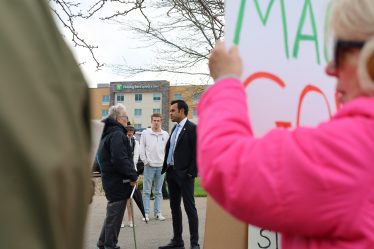Linnea Johnson
Contributing Writer
Note: Over the past months, the Voice has published numerous articles concerning sustainability at The College of Wooster, prompted by Rita Frost’s ’14 campaign encouraging President Cornwell to sign the American Colleges and Universities Presidents’ Climate Commitment (ACUPCC), a pledge for C.O.W. to become carbon-neutral within a feasible, self-determined time frame. In response to an Oct. 4th article titled “Petition asks Cornwell to sign Climate Commitment,” Director of Facilities & Physical Plant Operations Doug Laditka wrote a letter to the editors (published Oct. 18) in an effort to disprove a student’s statement that the College does an “awful job of energy saving and using energy efficiently.”
In his letter to the editors, Laditka asserted that the College has invested over $6 million to improve the energy efficiency of campus facilities over the past three years, especially through a new building automation system. Sb Loder, the College’s Sustainability Coordinator, recognizes the benefits of this investment, but also sees it as minor in relation to expenditures on other projects. When juxtaposed with the $30 million spent on the state-of-the-art Scot Center, this investment is not a large one. However, according to Laditka, these changes to buildings did save a profitable 2.5 million kilowatt-hours of energy within the first year after they were implemented.
Laditka also said that The College reduced its greenhouse gas emissions “by 30 percent” and reduced “the amount of heat used in campus buildings by 31 percent” between 2005 and 2012, despite an eight percent increase in total square footage on campus.
Loder clarified this data point, saying that the 30 percent decrease in emissions only accounts for heating and cooling and that the college cannot officially state that it has reduced its greenhouse gases by a certain percentage because it has not taken a comprehensive inventory of them.
Frost, who spearheaded the ACUPCC campaign, stressed that over 70 percent of the United States’ electricity comes from fossil fuels. Given that Wooster does not run off of renewable sources and wastes energy, Frost believes it is likely guilty of running close to that number.
“Walk down Beall during the winter and you’ll notice the windows of many a dorm open,” Frost said. “The heating and cooling systems we have are inefficient and leave students, faculty and staff unsatisfied. We waste so much energy heating our rooms and they get so hot that we [students] have to open our windows just to stay alive!”
The Scot Center’s solar roof is a centerpiece of Wooster’s sustainability initiatives. However, the amount of energy it produces is not widely known on campus. The only public display of the solar panels’ energy savings is a touch-screen television in the Scot Center Lobby.
Laditka wrote in his letter that the solar panels, which generate over 300,000 kilowatt-hours of electrical power, produce approximately two percent of the college’s electricity.
However, Loder emphasizes that it is important to make clear that the panels yields two percent of the electricity use, not total energy, of which it produces 0.6 percent. This number contributed to the Scot Center’s becoming Leadership in Energy and Environmental Design (LEED) Gold Certified.
While there may not be a consensus on the numbers regarding the College’s energy efficiency, it is clear that there is a demand for The College of Wooster as a whole to increase communication between all parties involved with the sustainability debate, including students, staff, faculty and administrators.
In his Oct. 25 viewpoint calling for student-administration dialogue, Jesse Tiffen ’15 wrote, “Without dialogue, students and faculty will just perpetually be miscommunicating. Establishing a greater dialogue and discourse with students and non-academic faculty members is the only way we can truly strengthen our college community.”
Regarding communication, Loder said, “It’s a touchy issue that sustainability on campus is grappling with.” She continued, “If we got more press, we could be doing even more.”
She said that while students do not have access to important numbers pertaining to sustainability, it is not the responsibility of the grounds coordinators to publish them, but rather the responsibility of the public relations office.
In student-administration discourse, differences in perspective are noticeable. Laditka, an administrator, focused on Wooster’s achievements up to date, saying “While there is still much the College can do in regards to sustainability, we have come a long way in the past few years and should celebrate our accomplishments and look to build on the successes.”
Loder, however, recognized that students focus predominately on the future: “The College is talking about how much better we are doing. Students are always looking toward how we could be doing better.”
Having observed other schools’ energy innovations, such as Kenyon’s GridSmart program and Oberlin’s commitment to be climate neutral by 2025, Frost said, “We students are not comparing our record to our previous track record but, rather, we are comparing ourselves to our neighboring colleges.”

